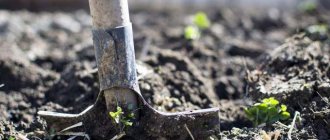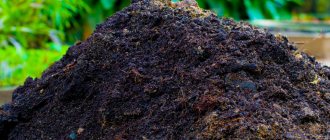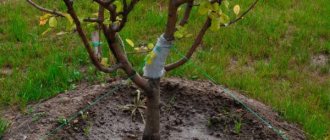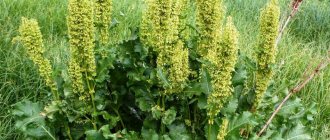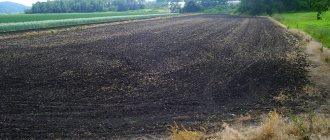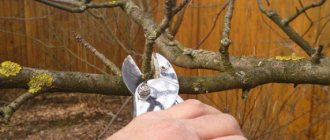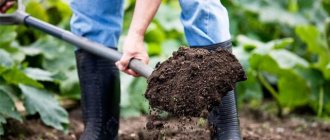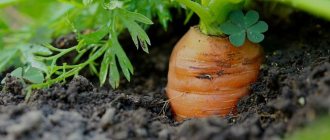Mineral preparations or organics
Manure is a natural fertilizer, the most famous and used in many large and small farms and private plots. This category of organic matter is considered a natural source of micro and macroelements, nitrogen, potassium, calcium, phosphorus, chlorine, silicon, etc.
Adherents of factory-made mineral fertilizers often treat manure as a fertilizer from the past and question its effectiveness. The composition of natural organic matter may not be balanced and depends on the type of animal, its food, the presence of bedding and other factors. While mineral preparations are used according to the instructions on the package, fully knowing the composition of the fertilizer. However, organic fertilizer has undeniable advantages.
First, manure does not deplete the soil. Regardless of the type and degree of overheating, organic matter is processed by microorganisms and bacteria in the natural environment. Nutrients are released from complex chemical compounds and become available to the plant root system.
Secondly, with the help of manure components, a special fertile layer of soil is created in the beds. Mineral fertilizing often only depletes the soil. Biomass is modified into humus, forming humus compounds necessary for all plants. The optimal humus content in fertile soil should be 85–90%. This indicator cannot be achieved with mineral supplements.
Thirdly, the versatility of manure fertilizer. Manure is used in fresh, semi-rotted, rotted form, as humus and a component for the production of various organic fertilizers. Not all plants tolerate fresh organic matter well; some are even harmed by it. But natural fertilizer in processed form can be used for any agricultural and flower crops.
Not common types of organic fertilizers
The waste of various animals is used as fertilizing, and the agricultural market offers a wide selection of organics. A natural question arises, which dung is better?
Pig manure. To use pig manure as fertilizer, the type of soil must be determined. On soil with a high lime content, pig fertilizer will create the necessary nutrient layer, which will ensure the active growth of vegetable crops. It is better to use well-rotted manure. First, a bedding of sawdust is added to the soil, then humus. Not used for fertilizing in greenhouse conditions.
When to use manure as a fertilizer is not recommended
Organics are not a universal fertilizer. Before applying manure in the fall, carefully inspect the raw materials. If there is a fungal coating on the soil, then feces cannot be used: the product hardly heats up, which negatively affects the heating properties.
There are crops that do not tolerate organic fertilizers well. With regular application, root crops are affected by scab, and the development of herbs is inhibited. If the site was fed with manure, then planting is best done after 2 years.
Farmers do not recommend using manure in the form of fertilizers in dense soil of greenhouses: raw materials do not decompose well in such soil. During the reactions, hydrogen sulfide and methane are produced. The resulting gas is dangerous for the roots of seedlings.
Horse and cow excrement contain beneficial components that help plants grow. If you know how and what to fertilize the soil with, it is easy to get a bountiful harvest of fruits and vegetables. Before applying manure to the soil, it is necessary to determine the volume and form of the product.
Horse dung
This organic fertilizer is a leader in its nutritional value and content of beneficial minerals. The fertilizer effectively nourishes the soil and serves as a natural stimulator of crop growth. When used, horse manure becomes less susceptible to various diseases.
A distinctive feature of this organic material is its ability to quickly decompose. This releases a huge amount of heat. That is why gardeners use horse substance in greenhouses as fuel to warm the beds.
Experts recommend using rotted manure, since the content of useful elements in it is three times higher than in the original. As a rule, for shrubs - 3 buckets per unit, for fruit trees - 5 buckets.
There are several main advantages of horse droppings:
- Guarantees active interaction of microorganisms.
- It loosens the soil well and retains moisture.
- Improves the chemical and physical properties of the soil.
- Provides optimal soil temperature conditions.
- Protects plants from unfavorable climatic conditions and various diseases.
Surprisingly, the only downside to organic horse material is that it generates a significant amount of heat.
When placing an excessive amount of horse droppings into the soil, there is a risk of burns and further death of crops. Especially the first 2 - 3 months. Therefore, experts recommend careful calculations.
There is one more nuance. There are not many horse farms left in the country. The number of horses is declining. Therefore, getting hold of the necessary amount of such fertilizer is becoming increasingly problematic.
What are the benefits of horse manure?
If we compare horse manure with the more familiar cow manure, it turns out that the first is drier, lighter, faster to decompose and contains more nitrogen, phosphorus and potassium. It heats up better, quickly releases heat, has a smaller number of weed seeds and is practically not affected by various pathogenic microflora characteristic of manure.
In terms of the degree of increase in productivity, it ranks first not only before cow, but also before pork, and before chicken, and even more so before goat, sheep and rabbit manure. It loosens heavy soils well, and when applied to light soils, increases their water-retaining effect. And what is also important, it does not contribute to acidification of the fertilized area.
Application of manure for different crops
Sometimes gardeners are interested in which manure is better - horse or cow - for cucumbers, tomatoes, etc. In principle, there are no rules about the advantages of using one or another type of organic fertilizer for this particular crop. Actually, for feeding you can use what you have at hand.
The only exception to the general rule is strawberries. The fact is that this plant is very demanding in terms of nitrogen. Therefore, the answer to the question of which manure is better (horse or cow) for strawberries is simple. Neither one nor the other. It is best to fertilize strawberries with bird droppings. It contains the most nitrogen.
Since horse manure releases a huge amount of heat when burned, it is most often placed in greenhouses under early crops. Therefore, this particular variety is an excellent answer to the question of which manure is better, horse or cow, for tomatoes. After all, tomato seedlings are planted in greenhouses quite early. In May, cow dung, which produces little heat, will do just fine for cucumbers.
Cow dung
Cow manure is considered one of the most popular types of fertilizers. It is a storehouse of many essential macro and microelements that contribute to the development and maturation of agricultural crops . Mullein may differ in its composition and appearance (depending on the age and sex of the animal). Therefore, experts advise using this fertilizer in doses, adjusted for the properties of garden crops and soil parameters. Mullein has the following beneficial properties:
- Contains all the necessary elements and substances useful for plant growth.
- Effective effect of manure on the soil. The result will not keep you waiting long.
- Magnesium and potassium reduce soil acidity.
- This type of organic matter reliably protects plants from various pests and many diseases.
- The cost of such feeding is relatively low. It won't be difficult to purchase it.
The disadvantages of cow droppings include a peculiar smell. Also, the balance of nutrients has not been fully studied (at the moment it is approximate).
When using manure, you need to remember that moderation is necessary in everything. Excess cow material can end up excessively enriching the product with nitrates. But this is only due to inept and irrational use.
Fertilizer composition
The types of organic matter under consideration, as noted above, are replete with various macro and microelements. Among the main ones the following can be noted:
- nitrogen, which directly affects plant growth (in horse manure - 4.7 g, in cow manure - 3.5 g)
- potassium , responsible for the rational use of water and promoting the formation of the root system; with the help of potassium, plants develop immunity to droughts and severe frosts (2 g: 1.4 g, respectively)
- calcium , involved in the neutralization of organic acids (3.5 g:2.9 g)
- phosphorus , the reserves of which affect the yield (3.8 g: 3 g).
You need to understand that these values are averaged. Actual numbers may vary in any direction. It all depends on the diet, the age of the livestock, and in what conditions it was kept.
In all respects, horse manure is still superior to cow manure. Experts note that horse droppings on heavy soil act as a loosening agent. Another very interesting detail is that the horses’ stomach absorbs almost all the seeds (unlike other animals) and only a small amount ends up in the ground.
| Manure, droppings | Content, g/kg manure mass | |||
| nitrogen | phosphorus | potassium | calcium | |
| Cow (mullein) | 3,5 | 3,0 | 1,4 | 2,9 |
| Horse | 4,7 | 3,8 | 2,0 | 3,5 |
Important information about cow manure
Fresh cow droppings are a semi-liquid substance that contains a significant amount of worm eggs and pathogenic microflora. When working with liquid mullein, you need to be careful and use gauze bandages and rubber gloves.
The recommended way to get rid of harmful parasites is by composting or infusing cow dung.
Cow manure is not used as often as biofuel by gardeners, as it does not create a very high temperature - only 24-45 degrees. A good result can be achieved if you make beds for cucumbers about 1 meter high.
Humus is used as fertilizing and mulching, to which cabbage, salads, cucumbers and zucchini respond well. It is useful to apply rotted manure in the fall under the placement of tomatoes, radishes, carrots, potatoes, beets and other root vegetables for next year.
Storage and processing features
When stored in bulk without compaction (in bags, piles), a lot of nutrients are lost, primarily nitrogen. The quality of such fertilizer is low. It can be increased by adding a small dose (about 3%) of phosphate rock.
When storing in bulk with compaction (cold method), the pile is formed in a cool place, on a flat area with a strong layer. The bottom is laid out with dry leaves, peat or earth, 25-30 cm thick. Then layers of manure and peat (or dry earth) are laid with mandatory compaction. Bring the height of the heap to 1.5-2 meters, and then cover it with film, turf or other available materials.
This method is suitable for storing fertilizer in winter. It is important to constantly monitor humidity (avoid drying out or waterlogging) and remove weeds in a timely manner.
How to fertilize correctly
For cow manure, the norm will be 7-10 kg per 1 square meter. m, but it needs to be applied once every 3 years if the soil is black soil; 2 years if the soil is sandy. Please note that light soil speeds up decomposition, so you will need less for a greenhouse than for open areas. Horse manure will require only 5 kg per 1 sq. m of territory. Usually it is laid on peat, and black soil is poured on top. The layer height should be at least 20 cm. Humus will warm your plants, and peat, as bedding, will retain moisture.
Pig manure is used only as humus due to the high content of parasites in raw and semi-rotted material. To improve the quality, peat and dolomite flour are mixed into it. When the soil is acidic, it is mixed with lime to increase the content of salts and calcium, which pig manure is poor in.
Rabbit excrement is used to feed trees and bushes, at the rate of 1.5-2 kg per 12 liters of water. To feed house plants, use powder in the following proportion: 3 tablespoons of soil to 1 tablespoon of manure. Peat is always used as a substrate for compost to provide a natural moisture sink. Sheep and rabbit feces are suitable for cold soil; due to its density and dryness, it decomposes more slowly. When choosing what manure to use on your site, take into account the above nuances and then your harvest will be rich, tasty, and healthy.
Secrets of proper manure preparation
A manure solution is used to water plants, which significantly improves the yield and quality of the fruits themselves. Fertilizing is carried out during the formation of ovaries and during fruiting. The fertilizer solution is prepared in a proportion of ¼: 1 - cow manure, 4 - water. It is mixed in a special container and left for at least 10 days. The solution must be stirred two to three times a day so that it is enriched with oxygen and the fermentation process begins, as a result of which uric acid is neutralized, because its excess has a detrimental effect on plant roots
The fermented solution increases the rate of formation of microbiological reactions in the soil, which increases productivity. All microelements contained in fertilizers begin to be absorbed by plants only after they are completely processed by soil microorganisms. During the preparation of the solution, the container must be kept tightly covered. Add 10 parts of water to the concentrate prepared in this way. For feeding use 5 l/m2. Since it is impossible to store ready-made fertilizer, because it loses its beneficial properties, it is better to calculate the volume in advance and prepare mullein at a time. To eliminate unpleasant odors during mixing and use, you can add silica (powder) to the solution.
To obtain high-quality fertilizer, and not ordinary and unprofitable biomass, manure is placed in pits (hills) in layers, making sure to compact each layer. The top of the recess is covered with leaves or straw. This harvesting method produces semi-rotted fertilizer with a high nitrogen content after 5 months. During loose storage (without compaction), a significant part of the organic nitrogen evaporates. Sometimes, when preparing manure, each layer is sprinkled with phosphorus flour in order to increase the content of this element in the organic fertilizer. In addition, superphosphate binds nitrogen, preventing it from evaporating. And nitrogen protects the fertilizer from freezing.
Types of manure (by degree of maturity)
The quality and types of compost are determined not only by its origin, but also by its degree of maturity. It is important to know when it is better to use humus, what to mix chernozem with, what soil to fertilize and at what stage. This will help improve the overall health of the garden.
- Fresh manure is used extremely rarely, due to the high content of harmful organisms, nitrogen, and weed seeds. Requires careful processing before use to reveal its positive qualities.
- Semi-rotten fertilizer - applied to the ground in the fall, at the rate of 5 kg per 1 sq. m. At this stage of processing, they feed cabbage, pumpkin, spinach, cucumbers, and zucchini. It also requires caution in application - be sure to dilute the manure, water around the plant, but not to the very root.
- Rotted manure - much lighter in weight than fresh raw materials, is usually applied to the soil in the form of a mixture. If you decide to dig up an area, then you will need 10 kg of rotted mass per 1 square meter. m of garden, peat for the base.
- Humus is the last stage of transformation of manure mass. In terms of its qualities and composition, it is the most useful for your plantings. It is used for mixtures (peat and black soil are often used) to improve the soil. Humus is a welcome guest in the holes of onions, radishes, potatoes, tomatoes, and herbs. To apply, you should dig up the garden in the fall and mix humus with soil in a ratio of 1:4.
Which humus is best for the garden?
I wonder what gardening experts recommend? Which humus should be preferred - cow's or horse's? Which one can be used to benefit our soil? Note that each of the proposed types has a number of its own advantages and disadvantages.
Please note that horse humus is significantly superior to cow fertilizer in terms of increased content of various nutrients and nitrogen. The main positive aspect of cow humus is its low cost and availability; this often serves as a determining aspect in the choice of fertilizer.

